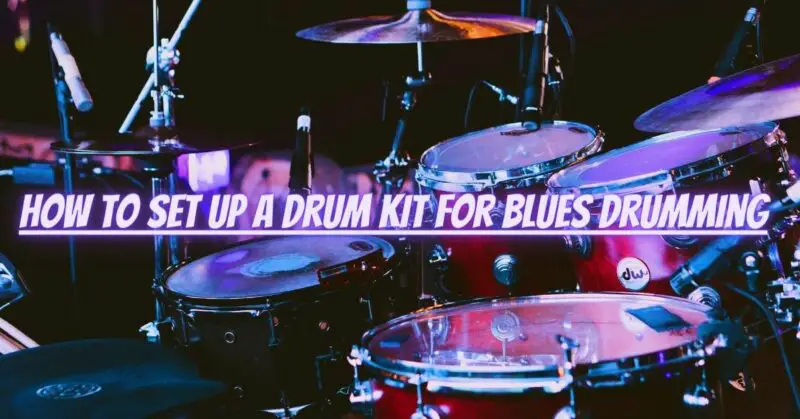The blues is a genre deeply rooted in rhythm and groove, and as a drummer, your role is crucial in creating the infectious feel and drive that defines blues music. Setting up your drum kit appropriately for blues drumming can enhance your playing and help you deliver the signature blues sound. In this article, we will guide you through the process of setting up a drum kit specifically tailored for blues drumming, considering key elements such as drum sizes, drumheads, cymbals, and tuning.
- Choose Drum Sizes for Warmth and Resonance: When setting up a drum kit for blues, aim for drum sizes that produce warm and resonant tones. Opt for a 20″ or 22″ bass drum to achieve a deep and round sound. Consider a 12″ or 13″ rack tom for crispness and a 14″ or 16″ floor tom for added depth. These sizes provide a balanced tonal range that complements the blues genre and allows for expressive playing.
- Select Drumheads for Warmth and Vintage Tones: To enhance the warmth and vintage character of the blues sound, choose drumheads that offer controlled sustain and a focused tone. Coated drumheads, such as coated ambassadors or vintage-style heads, can provide the desired warm and slightly muffled sound. Experiment with different brands and thicknesses to find the combination that suits your preference and the specific blues style you’re playing.
- Focus on Snare Drum Characteristics: The snare drum is a centerpiece in blues drumming, providing the crisp, cutting sound that drives the music. Select a snare drum with a medium to high tuning range, allowing for versatility in producing both tight and loose snare sounds. Consider using a wooden shell snare drum, such as maple or mahogany, to achieve warmth and depth. Experiment with different snare wires and tunings to find the sweet spot that delivers the desired blues snare sound.
- Choose Cymbals for a Vintage Vibe: Cymbals play an essential role in blues drumming, contributing to the overall vintage vibe and character. Look for cymbals with darker and warmer tonal characteristics. Consider traditional or dark ride cymbals that produce a smooth and mellow ping. Select medium-weight crashes that provide a balanced blend of brightness and warmth. Hi-hats with a lower-pitched “chick” sound can complement the blues groove effectively. Experiment with different cymbal combinations to find the blend that suits your style and captures the essence of the blues.
- Emphasize the Ride Cymbal: In blues drumming, the ride cymbal often carries the rhythm and maintains the groove. Position the ride cymbal at a comfortable height and angle, allowing for easy access and comfortable playing. Experiment with playing patterns on the ride cymbal, incorporating various sticking techniques and accents to enhance the blues feel and drive.
- Pay Attention to Tuning: Tuning is crucial in achieving the desired sound for blues drumming. Experiment with different tunings to find the sweet spot that enhances warmth and resonance. Aim for a medium tension on the batter heads for the snare drum and toms, providing a balanced response and sustain. The bass drum can benefit from a moderate to low tuning to achieve a deep and punchy tone. Be attentive to each drum’s individual tuning, ensuring they complement one another and create a cohesive sound.
- Incorporate Brushes and Mallets: Blues drumming often calls for the use of brushes and mallets to achieve a softer and more intimate sound. Consider adding these tools to your setup to expand your tonal options. Brushes can provide a smooth and subtle texture, while mallets can produce a warm and rounded tone on the toms and cymbals. Experiment with different playing techniques to explore the dynamic range and versatility they offer.
- Experiment and Embrace Individual Style: While guidelines can assist in setting up a drum kit for blues drumming, it’s important to remember that personal style and preference play a significant role. Experiment with different setups, cymbal placements, and drumhead combinations to find the unique configuration that suits your playing style and enhances your musical expression. Embrace the opportunity to develop your own signature sound within the blues genre.
Conclusion: Setting up a drum kit for blues drumming involves careful consideration of drum sizes, drumheads, cymbals, tuning, and the incorporation of brushes and mallets. By selecting warm and resonant drum sizes, choosing appropriate drumheads, opting for cymbals that deliver a vintage vibe, paying attention to tuning, incorporating brushes and mallets, and embracing individual style, you can create a setup that perfectly captures the essence of blues drumming. Remember, the blues is about groove, feel, and emotional expression, so take the time to explore different sounds and configurations to find the setup that allows you to deliver the authentic blues sound and elevate your playing in this timeless genre.


